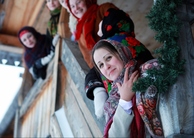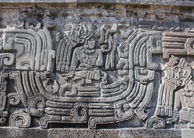Featured Article:The Dead Bodies of the West African Ebola Epidemic: Understanding the Importance of Traditional Burial PracticesSociety, Culture, and Burial Conflicts within the Current Ebola Virus Disease EpidemicEbola virus disease continues to devastate West African nations, specifically Sierra Leone, Liberia, and Guinea since it first originated in the area. This current outbreak is said to be the largest ever recorded and has been spread almost exclusively through human contact (Richards, 2015). The World Health Organization reported in September 2015 that there were approximately 28,256 confirmed cases of Ebola virus disease and over 11,000 reported deaths the Upper West African area (World Health Organization Ebola Situation Report 16th September 2015)). Currently Sierra Leone and Guinea a experiencing a decline in confirmed cases and Liberia has been declared free of Ebola virus transmission in the human population since September 3rd. It is vital to understand the role of social factors in the transmission of this disease and methods of stopping its spread. The effects of Ebola virus disease go beyond the spread of the infection and death rates to include many other social, cultural, and economic factors. Especially, in Sierra Leone, Liberia, and Guinea, whose entire way of life has been taken over to contain the spread of Ebola virus disease, their social structure has been greatly impacted. Key social impacts due to Ebola management are found in strained contact relationships and restrictions on important funeral and mourning traditions. In order to understand the social tension between those who are affected by the disease and the health care workers and organizations, the current situation of the disease must be recognized. Misconceptions About Ebola in West AfricaTo accurately understand the social tension between the West African cultural groups affected by the Ebola virus disease and the healthcare organizations attempting to control its spread, it is important to discuss common misconceptions about the Ebola virus. These misconceptions often are the core reasons why families of the victims are adamantly fighting to keep the bodies of their loved ones to conduct traditional burials instead of allowing prepared burial teams to handle the infected bodies. All of these misunderstandings drastically impact how families and victims react to Ebola virus disease and the healthcare workers there to help contain it.An important misconception about Ebola virus disease concerns its transmission process. Ebola virus disease is confirmed through molecular evidence to be transmitted through contact with the bodily fluids of infected persons (Richards, 2015) but it is commonly misunderstood to be an airborne disease (Shittu, 2015). The virus may also be transmitted through contact with contaminated objects. A singular instance when the disease may be transmitted through the air is if there are airborne droplets of bodily fluids that may reach another person. Confusion about how Ebola virus disease is transmitted may lead to changes in how families and victim react to the virus. Believing that it is transmitted through the air prevents families from leaving their homes to seek care for their loved ones if they think the hospital air might be contaminated with the virus. Ebola virus disease is also believed to be transmitted though mosquitos and bacteria which may lead to attempts of ineffective prevention measures by families (Shittu, 2015). The course of how the Ebola Virus Disease spreads through the human body leaves the dead body very infectious. Once the Ebola victim has died, the virus is able to overtake the entire body and manifest in the most serious consequences of the disease and thus increase its overall level of contagiousness. After death, the body of an Ebola victim may release many infectious bodily fluids, such as blood and urine, which may easily infect anybody responsible for handling the corpse (Richards, 2015). Since the transmission of Ebola virus disease occurs through direct contact with bodily fluids, dead victims become the most dangerous threat to the spread of infection because they discharge high quantities of bodily fluids. Another misconception about Ebola virus disease is that once someone contracts the disease they will not survive. Though the death rates from contracting Ebola virus disease have been very high, there have been a substantial number of survivors of Ebola virus disease in West Africa as well as those who have come to Western nations for treatment. According to recent data from the World Health Organization, about one in three patients will survive Ebola virus disease mostly due to efficient care provided by health care workers (World Health Organization Stories of Ebola Survivors). Many of these survivors are using their experiences to help Ebola containment efforts in their own communities by educating the public and sharing their stories. Being a survivor of Ebola virus disease though, does come with its consequences. Many of the survivors are discriminated against in their communities because they are believed to have not fully recovered from the disease and thus are still contagious. Reintegration into society often becomes very difficult for survivors and the stigma associated with Ebola virus disease extends to the survivor’s families as well. A notable example of this is in the case of Liberian basketball player Kaizer Dour. The stigma associated with having Ebola Virus disease was so effective on his family that Dour had to have a secret funeral in order to mitigate the effects of the stigma on the rest of his family (Onishi, 2014). Two more misconceptions about Ebola are related to each other. One is the issue of West Africans, specifically Liberians, believing that it is actually the health care workers that are bringing in the Ebola virus disease. This misconception directly comes from a long established political tension in the area between the government and the local people. A consistent mistrust of all government activities has convinced many people that Ebola virus disease was a lie put in place by the government to wipe out certain indigenous groups. The population's distrust of the government stems from a brutal civil war ending about a decade ago as well as a history of the government falling short on its promises (Frankfurter, 2014). Consequently, this strong distrust of the government impacts healthcare workers who were brought in by the government and the hospitals, which are run by the government. Another example of the effects of government mistrust on health choices occurred when the Liberian the government ordered that all Ebola victims be cremated because of a lack of appropriate burial sites. Though cremation was not part of Liberian burial traditions, the government still mandated it because of the disease threat. Thinking that this was just another ruse to wipe out more indigenous populations, many families refrained from taking their loved ones to hospitals even if they had Ebola virus disease and instead victims were cared for at home and secretly buried (Hinshaw, 2014). Interactions Between the Ebola Burial Teams and West African FamiliesA combination of logistical issues, inadequate infrastructure, conflicts with healthcare providers, and native burial traditions led to great difficulty in preventing the spread of Ebola. Towards the beginning of the epidemic in West Africa, the World Health Organization and Center for Disease Control both published clear guidelines describing how Ebola victims should be transported and buried to effectively prevent the spread of the disease. Though both sets of guidelines recognized the cultural practices and the religious beliefs of the family of the victim, they argued that containing the spread of the disease should take precedence over completion of traditional burial rituals. It is important for transporters and burial teams to help families understand that they cannot exercise all of their mourning rituals because doing so would severely increase the risk of infection. Certain traditional burial practices have been identified as posing serious threats for spreading infection and these are the ones that pose the most difficulties between healthcare workers and victim’s families. Any burial ritual that requires directs physical contact with the body of the victim may lead to the spread of the infection. In most cases the Ebola victims are buried immediately when they leave the treatment center because this practice minimizes poor handling of the bodies and cushions the family members from contracting the infection. In these situations, family members are forced to detach themselves from the bodies of their loved ones, who are then buried outside of their communities. The burial places for Ebola victims are often designated in areas that are very secluded from villages to avoid transmission (Pandey, 2014). The health organizations working in Liberia, Sierra Leone, and Guinea usually prefer that the bodies of the Ebola victims be buried in mass graves so that there is less contamination close to the communities (Oleribe, 2015). Furthermore, burying the dead in mass graves reduces the risk of contamination through scattered burial sites. Another preferred burial method is through cremation because the intense heat will permanently destroy the virus and the infectious bodily fluids (Wolz, 2014). Many West African ethnic groups have strict religious rules about who may handle the bodies of the dead, as well as how they must be handled. Some of the traditional rules govern how the body will be touched, washed, or kissed prior to burial (Cooper, 2014). However, many of the traditional methods are in direct conflict with the recommended procedures for handling the bodies of Ebola victims to ensure a minimal risk of infection and spread of the disease. Rather than allowing the body to be traditionally handled through appropriate rituals, the Ebola burial teams in West Africa prefer increased safety when handling a body. Typically, a burial team, fully covered in protective gear, will drench the body with bleach, cover it with two body bags, and then bury it at least six feet into the ground (Hinshaw, 2014). Though neglecting the wishes of the victims’ families, this method minimizes the risk of the infection spreading. Health care organizations working in Liberia, Sierra Leone, and Guinea have made significant efforts to discourage communities from practicing their mourning and burial traditions because they encourage the spread of Ebola virus disease in the community (Bausch and Lara, 2014). The health care workers in those countries are taught to strongly urge the local community members to abandon their traditional rituals at least until the threat of Ebola virus disease subsides. As a method to control the spread of the disease, some health organizations in the West African countries have opted to allow partial adherence to the burial traditions of the communities. In particular, family members are allowed to look at the faces of their deceased loved ones for one last time before they are zipped up in a body bag (Wolz, 2014). Health care workers ensure that the family viewing the victim’s body is at a safe distance so that they cannot touch the body. Health workers will also take the responsibility of washing the body of the deceased in partial adherence to the West African washing ritual, albeit in a strong disinfectant and chlorinated water. After washing the body, it is put into a body bag, disinfected again, and then put into a second body bag. The second body bag guarantees that there is a minimal chance of further contamination from the infected body that is still emitting bodily fluids containing the Ebola virus disease (Richards, 2015). The actions of the healthcare workers and burial teams over regulating the bodies of the Ebola virus disease victims has caused many families to take action in protecting their loved ones by providing them with a completed traditional burial ritual. In Sierra Leone, many families are known to hide or take the bodies of Ebola victims in order to conduct the proper burial (Frankfurter, 2014). Other families might bribe healthcare workers to change the cause of death on the death certificates of the Ebola victims to allow their body to stay at home with the family so traditional mourning rituals can be conducted (Vogt, 2014). Many Liberian families have resorted to secretly burying their dead to avoid the control of the regulating organizations and this practice has led to a serious discrepancy in the real death toll numbers in Liberia. The burials are not documented because the dead bodies are taken to a nearby island, called daka or vulnerable area, by fishermen in the middle of the night for a proper Liberian burial ceremony (Hinshaw, 2014). Social Tensions Surrounding the Needs for the Victim’s BodiesThe basis for the social tension surrounding burials in the Ebola stricken countries, Liberia, Sierra Leone, and Guinea, is that the government and health aid workers insist that the bodies of Ebola victims must be handled in a specific way but the local ethnic groups have their own traditional burial rituals that need to be followed. Unfortunately, the basis for the traditional West African burial rituals requires physical contact with the dead body, which can become a great danger for the transmission of Ebola virus disease. The people living in Liberia, Sierra Leone, and Guinea refuse to either accept or understand the measures taken by the health officials to contain the spread of Ebola virus disease. To these communities, there is nothing more important than giving their dead a proper burial and appeasing their spirits. Burying the dead in mass graves or what is considered worse, without the presence of their families, is detrimental from the perspective of these West African communities (Richards, 2015). Additionally, West African philosophy also believes that men should not have the same burial ritual or burial site as women and children. This situation of disagreement has resulted in a lot of mistrust between the West African communities and the health workers in the area. Additionally, in reference to the washing rituals done on the dead bodies, West African philosophy dictates that males should wash dead males and dead women should be washed by women (Richards, 2015). Another practiced burial ritual that connects to Ebola virus transmission is that wives are required to shave the heads of their dead husbands and then be smeared with mud made from their husband’s body’s washing. The significance of this ritual is meant to protect the wife from any jealous spirits and thereby prepare her for inheritance by one of her husband’s brothers (Richards, 2015). Therefore, though there is an obvious opportunity for the Ebola virus to infect the wife through the mud she uses, there would be many negative spiritual effects of not completing the ritual. The importance of mobility for people in West Africa when properly completing burial rituals is another contributor to the increased social tensions surrounding burials. A notable example of how transportation contributes to the spread of Ebola virus disease is in the context of when a wife dies. When a wife dies, her body is usually transported back to her family that lives in another village. Furthermore, if the wife dies before the dowry is completely paid, then the husband will bring the wife’s body to her village to settle the outstanding debt and then take her body back to his village to bury her (Richards, 2015). This movement of the body back and forth poses a large risk for Ebola transmission to the people living in the other villages. West African religious philosophy supports that when the body of the deceased is not allowed to have the proper burial ritual it is understood as an attack on the wishes of the deceased person. This allows the angry spirit of the deceased person to return to the world of the living to harm the living family members in the form of haunting (Faye, 2015). Often, what is even considered worse than not allowing the families to perform the traditional burial rites is to remove the body from the presence of the family members (Faye, 2015). Families in Liberia believe that if funerals are not conducted in the traditional way it will also lead to poor agricultural production. Specifically, the rice production will be harmed because of a curse from the ancestors (Richards, 2015). The connection between fulfilling appropriate funeral rituals and abundant crop production further explains the importance of completing the burial traditions.Continued on Next Page » Suggested Reading from Inquiries Journal
Inquiries Journal provides undergraduate and graduate students around the world a platform for the wide dissemination of academic work over a range of core disciplines. Representing the work of students from hundreds of institutions around the globe, Inquiries Journal's large database of academic articles is completely free. Learn more | Blog | Submit Latest in Anthropology |
















